KVM switch
A KVM switch , which stands for English Keyboard Video Mouse to German as keyboard-screen-mouse switch , allowing multiple computers with a single mouse , a keyboard and a screen to control the means of switches the system to be controlled be switched on.
Depending on the type and scope of the KVM switch, USB devices and speakers can also be switched and shared. In hardware-based remote maintenance interfaces such as the Intelligent Platform Management Interface (IPMI), KVM switches are built into the computer hardware as part of the baseboard management controller and thus allow the computer to be controlled via a computer network independently of the software .
Executions
External KVM switches differ in the number of computers the user can connect. Depending on the variant, you can control two or more computers from one workstation; some KVM switches can also be daisy-chained ( cascaded ) in order to reach a larger number of controllable computers. When cascading, the computer port of a KVM switch is forwarded to another KVM switch.
Monitor, keyboard and mouse are connected directly to the KVM switch. In addition to standard cables with VGA + 2 × PS / 2 (newer ones with DVI and USB), proprietary cables (e.g. with DB25 plugs on the KVM switch) are available for connecting the KVM switch to the computers it operates that the connection can be established more quickly and mechanically more stable, and there are KVM switches with modular connections that use an adapter for each computer on its respective connections, so that standard Ethernet cables can be used for the line in between .
Switching is done using a key , rotary switch or hotkeys ( key combination or pressing a specific key on the keyboard twice). The KVM switch (with the exception of older, purely mechanical switches) uses keyboard and mouse emulation to ensure that the connected computers continuously perceive both devices as connected and that their settings are saved separately for each computer. This avoids malfunctions in the operating system or drivers and the respective hardware. Almost all KVM boxes use LEDs or numeric displays to indicate which computer is currently being used.
For workstations with two or four screens there are special KVM switches for dual video or quad video . For this purpose, other models can be coupled with one another and thus switched over synchronously.
Larger KVM switches, for applications in data centers, for example, have connections for two or more workstations and allow several users / administrators to work on different computers at the same time. Such devices are called "multi-user KVM switches" or "matrix KVM switches". The simultaneous access of several administrators to the same computer is usually blocked. Devices of this size have a complex security system with password protection and restriction of the individual users to certain computers. In large systems, the computers are selected via OSD menus that display the previously configured name of the computer. The configuration is also done via OSD.
KVM connections over a network
KVM over IP ( KVM over IP , IP KVM ) is especially in the professional field of meaning. With a switch with KVM over IP technology, the keyboard, monitor and mouse are not connected directly to the KVM switch, but to a networked PC ( remote client ) with a Java-based browser or special software. This communicates via TCP / IP networks with the KVM over IP switch to which the computers are connected. The switch converts the screen output from the computer (encoder) and transmits it to the remote client (decoder), which sends the keyboard and mouse information to the switch in the opposite direction. KVM over IP allows the connected computers to be controlled without physical access to the KVM switch, and thus remote control from any workstation in your own network or via the Internet . An example of this is the manufacturer-independent standard Intelligent Platform Management Interface . For this, restrictive security measures are required when accessing these interfaces.
Compared to purely software-based remote administration methods, which run as a separate process in the operating system (e.g. VNC , terminal server ), a KVM switch has the advantage that it allows remote administration even if the corresponding software component is on the remote computer is not running or is defective. In this way, BIOS settings on remote computers can also be changed via a KVM switch .
Operating system support
KVM switches only became widespread in the server environment with the advent of the Microsoft Windows 2000 and Windows 2003 operating systems . These operating systems cannot be controlled satisfactorily without a keyboard, monitor and mouse. In the traditional Unix server environment , KVM switches are not widespread, as this type of computer can be completely remote controlled via a simple text console, via the network or even via the serial interface .
Digital KVM over IP switches have an optional feature called Virtual Media. This allows administrators to transfer data between their local computer and remote servers and thus carry out a large number of tasks from their desks. This includes performing diagnostic tests and patching the operating system and application software. It does not matter which platform the various computers are based on and which operating system is running on them.
KVM splitter
The counterpart to the KVM switch is the KVM splitter (CPU sharer, reverse KVM switch). Such a switch offers the possibility of connecting several consoles (consisting of keyboard, mouse and monitor) to one computer. This is useful, for example, if a PC is to be made accessible in several places (workstations).
KVM extenders
To extend the permissible distance between computer and KVM switch or between KVM switch and workstation, there are KVM extenders that transmit the keyboard and mouse signals without interference and the video signals without excessive loss of quality over greater distances than without amplification it is possible.
In contrast to a pure amplifier for the signals, other cable types can often be used here, in particular Cat5 cables with modular connections (commonly known as RJ45), such as those used with Ethernet (100BaseTX or 1000BaseT). Therefore, the infrastructure that is usually available or required anyway can be used even more flexibly, namely to extend the KVM lines. For this purpose, a cable (eight-core) is completely occupied; simultaneous use with Ethernet or TCP / IP is not possible, unlike KVM over IP (see KVM connections over a network ). Depending on the cable length and information from the manufacturer, a larger cable cross-section than for Ethernet may be required in order to limit the signal attenuation to permissible values.
A device is connected to each end of the line, typically a transmitter and a receiver device. Both have to match, so they are usually sold as a pair.
A KVM switch can also contain one or more KVM extenders. You also need a receiver or transmitter for the other end of the respective line.
KVM management systems
KVM management systems combine all access to computers via KVM-over-IP devices in a standardized user interface. The integrated rights management ensures that every administrator only sees and can select the computers on the user interface for which he is responsible. In addition, Power Switches over IP can also be included in the management system, so that administrators with the KVM connection also have all power switch functions for the selected computer available.



